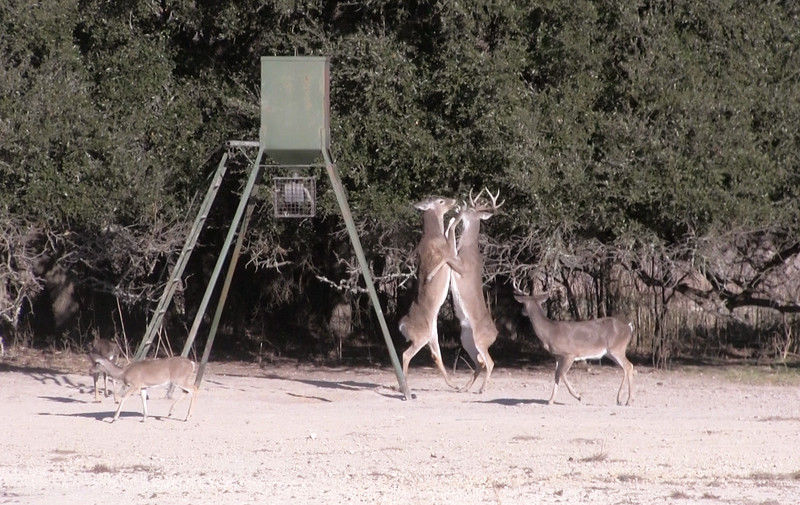CWD discovery in free-range deer brings mandatory check stations to three counties
Published 6:47 am Monday, June 5, 2017

- STEVE KNIGHT/TexasAllOutdoors.com THE DISCOVERY OF CHRONIC WASTING DISEASE in the Hill Country is going to result in some hunters have to go to check stations. Reducing deer numbers is one way to possibly help prevent the disease from spreading.
It should not come as any surprise, but Hill Country deer hunters in a portion of Bandera, Medina and Uvalde counties are going to have to jump through a few hoops beginning this season.
After the discovery of Chronic Wasting Disease in a free-ranging white-tailed deer late last season along with several pen-reared deer in Medina County the last three years, the Texas Parks and Wildlife Department has announced it will switch to a containment zone plan requiring hunters to visit check stations for mandatory testing of harvested deer. It will also fall under restrictive carcass regulations beginning this season.
Trending
The area within the new containment zone includes the southwest corner of Bandera County, the northwest corner of Medina County and the northeastern edge of Uvalde County.
Because all of the deer that had previously tested positive for CWD had come from behind high-fenced operations last season, the impacted area was within what the department called a surveillance zone. That meant testing of harvested deer was voluntary and there were no restrictions on the movement after harvest.
“At this time we are planning to set up two check stations in the Medina County area, likely to be Hondo and Tarpley again, but we have not confirmed check station locations yet,” said Alan Cain, TPWD white-tailed deer program leader.
Cain said hunters are required to bring in an unfrozen head and at the very least two or three inches of neck below the head within 24 hours of harvest. This allows biologists at the check stations to collect lymph nodes at the base of the skull for testing.
This is the law within the zone. Failure to do so could result in the hunter being charged with a Class C misdemeanor, but Cain said the goal of the department is compliance, not issuing tickets.
Hunters wanting to take a deer head from the area to a taxidermist should ask for a Deer Head Waiver at the check station. Among other things it tells taxidermists in other portions of the state is how they should handle parts of the deer not used in the mounting process and how they can contact TPWD so a local biologist can collect samples for testing.
Trending
“TPWD will not be notifying taxidermists across the state to be on the lookout for these deer. The head waiver form has instructions for taxidermists receiving these deer on how to properly dispose of unused parts and the hunters must give the waiver to the taxidermist. We work with hunters to make sure one of our biologists will be able to collect a sample after the deer gets to a taxidermist and is caped out. Most of the time it is a simple phone call to coordinate with the taxidermist for us to stop by and pull the sample,” Cain said.
Hunters in the new containment zone will only be permitted to transport meat out if it has been quartered with all brain and spinal cord tissue removed, boned meat or cut and wrapped meat.
To dispose of the carcass, the department recommends burying the carcass on the ranch it was killed or in a landfill.
Cain said the department’s present goal continues to be monitoring to determine if and where the disease has spread.
“Our goal for the immediate future is to continue CWD sampling in the zone to better determine the geographic distribution in the zone as well as prevalence to help us determine best management options to contain CWD within the zone. Additionally we continue to educate landowners and hunters in the zone on CWD and how they play a role in the management of CWD,” he said.
With just one free-ranging case discovered within the containment zone, Cain said there is no long-term plan at this time.
“There’s not a single standardized approach to responding to CWD. Each situation has to be carefully evaluated and use the best science available to make appropriate management decisions. Continued sampling of hunter-harvested deer will be necessary to get a good handle on the geographic distribution of CWD within the zone. If additional positives are found in low-fenced country, then we would likely evaluate our current CWD zone boundaries to determine whether modification of the zone boundaries are necessary to minimize or prevent spread of CWD into new areas,” Cain explained.
The zone begins at U.S. 90 in Hondo then west to Farm-to-Market 187 in Uvalde County, then north to FM 470 in Bandera County then east to Tarpley then south on FM 462 back to Hondo and U.S. 90.
For more information on CWD, go online to https://tpwd.texas. gov/huntwild/wild/diseases/cwd/#checkMap.
Have a comment or opinion on this story? Contact outdoor writer Steve Knight by email at outdoor@tylerpaper.com. Follow Steve on Facebook at Texas AllOutdoors.






